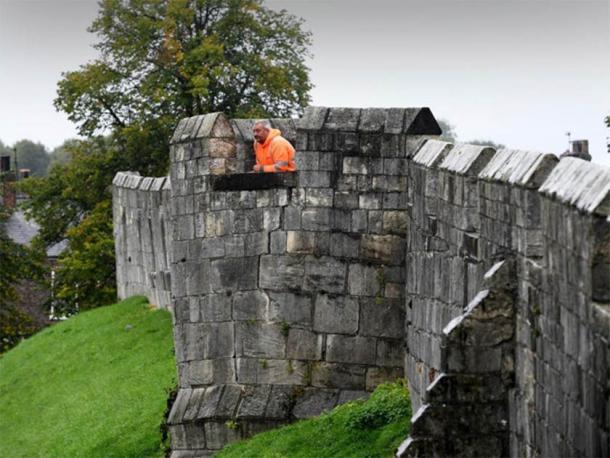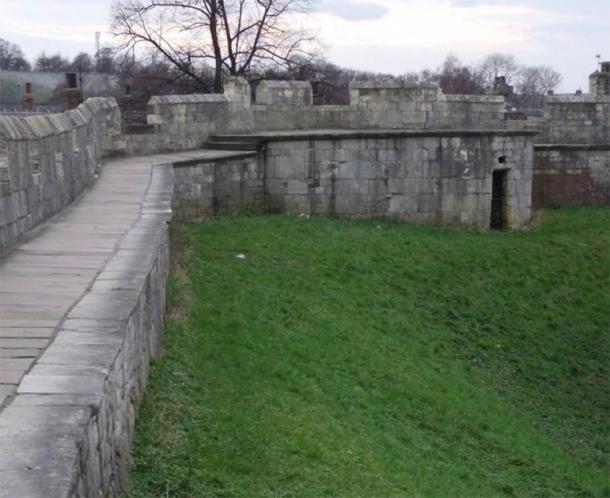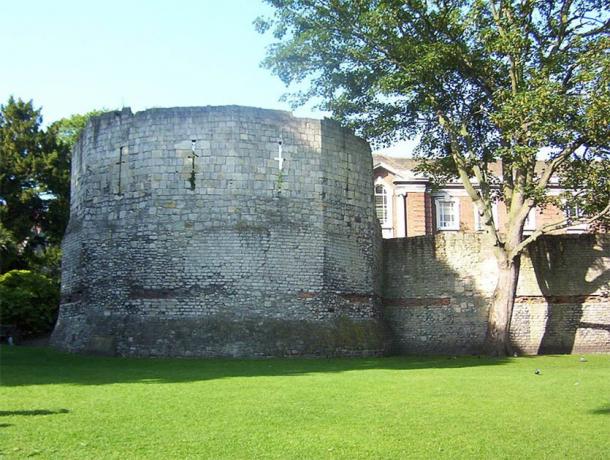A major excavation has been announced to investigate the famous city walls of York. The city walls are considered some of the finest in all of the British Isles if not Europe. These walls have played an important part in the history of Britain and many exciting discoveries are expected.
York is a beautiful city in the north of England, and it is extremely popular with tourists, drawn by its architecture and history. These ancient fortifications have come to symbolize the identity of the city. The city has many miles of walls and they are generally 13 feet high and 6 feet wide (4 by 1.8 meters). They are especially popular with visitors who can walk the walls and view its many towers. One small section of the ramparts showed sign of stress because of the massive weight of the walls’ walkway.

Rampart with crack, giving way to stress from weight of walkway. Simon Hulme / Yorkshire Post
Worrying Cracks in Tower
Urgent work is needed to reinforce a 14 th-century tower on the walls, which is showing some signs of instability. For the past five years, the tower has begun to fissure and crack because of the infill from a walkway. The tower, known only as number 2 is situated between the larger Baile Hill tower and the curiously named Bitchdaughter Tower. It was built to strengthen the city’s original walls and the walkway that is now causing it to buckle was constructed in the 1700 or 1800s. Little more is known about its history.
Dr Louise Hood who helps to manage the walls told the Yorkshire Post that ‘Normally if we found a crack, we might pin it together, or put mortar in’. However, it was deemed that the best approach to stabilizing the structure was to excavate the walls. During the excavations under the walls, stonemasons will work to restore the tower. The project is supported by Historic England and will take up to four months.

The curiously named Bitchdaughter Tower, on the York wall. This tower was once much larger, 2 or 3 storeys, and used as a Royal prison. ( © Matthew Hatton / CC BY-SA 2.0 )
The Northern Roman Stronghold
The planned excavations are hoped to reveal more about the history of York’s walls. Roman legions built a castle ( castra) here in the 70s AD. Eboracum, as it was known by the Romans, was one of the most important Roman settlements in Northern England. In an earlier article, Ancient Origins reported that ‘This settlement became a city and one of the most important in Roman Britain and Yorkshire over time became increasingly Romanized’. But by the 5 th century AD, it was abandoned after the withdrawal of the Roman legions to Gaul in 410 AD.
Viking York
There are hardly any remains of the original Roman walls apart from a sole standing tower. Britain Express reports that ‘The most notable Roman remain is the Multangular Tower’. This 10-sided structure was one of the 10 towers on the walls and it was built by Emperor Septimius Severus (210 AD). The planned excavation may reveal if there was a Celtic settlement on the site before the coming of the Romans.

The Roman Fortifications showing wall and Multangular Tower in Museum Gardens York. ( CC BY-SA 3.0 )
After the end of Roman rule, York became part of an Anglo-Saxon kingdom, and it seems that the walls fell into disrepair. In the 9 th century, the Vikings of the great ‘Heathen Army’ occupied this part of England and made York the capital of a powerful kingdom, known as Jorvik. Over time they rebuilt the ancient ramparts and ‘began by covering the Roman walls with a broad earth embankment crowned with a timber fence’ according to The History of York . William the Conqueror during his campaign to subdue the Anglo-Saxons in Northern England took York and during this attack, its walls were severely damaged.
Authentic Medieval Walls of York
The city prospered because it was the seat of the Archbishop of York. The majority of the walls were built between the 12 th and the 14 th century when the city was one of the most important in England. They probably replaced wooden walls. York was the headquarters of Charles I in the English Civil War, but the city was besieged and captured by the Parliamentarians (1646), the walls escaped relatively unscathed at this time.
The only additions to the medieval walls were the walkway in the modern period. Unlike many other cities and towns in Europe, York managed to preserve its medieval walls. “Most people walk the city walls and think they are standing on Roman walls, Dr Hood told the Yorkshire Post.
Dr Hood is quoted by the Yorkshire Post as saying, ‘We’ve got this fantastic opportunity, with an excavation and trial pits, to see if we can find out what was there before’. The work means that they can better understand when the tower was built, and an insight into what structure existed there previously. The work may reveal something about an abandoned fortress that once stood in this part of the city. A new temporary walkway has been erected to allow visitors to walk the famous walls and enjoy the sights of York.
Top image: The York walls run for miles around the old city of York. Source: Colin & Linda McKie / Adobe Stock
By Ed Whelan
Related posts:
Views: 0
 RSS Feed
RSS Feed

















 September 25th, 2020
September 25th, 2020  Awake Goy
Awake Goy 


 Posted in
Posted in  Tags:
Tags: 
















